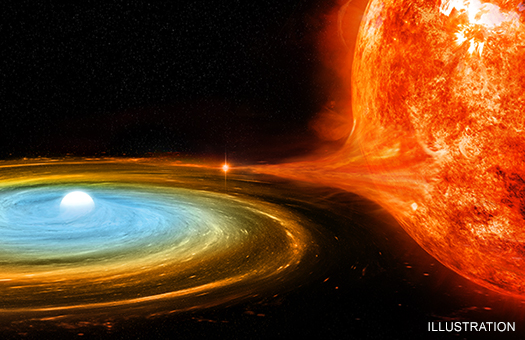Cosmic Fountain Powered by Giant Black Hole
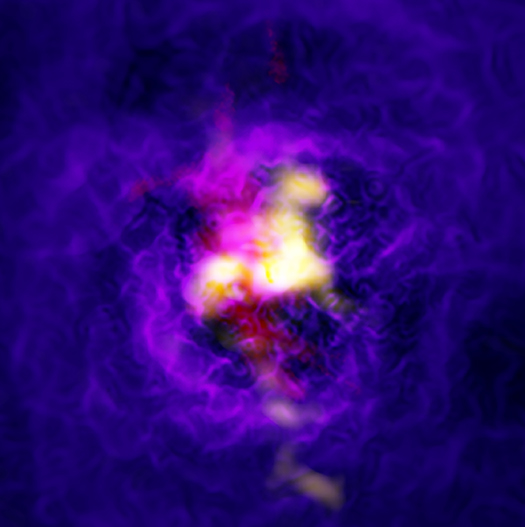
Abell 2597
Credit: X-ray: NASA/CXC/SAO/G. Tremblay et al; Radio:ALMA: ESO/NAOJ/NRAO/G.Tremblay et al, NRAO/AUI/NSF/B.Saxton; Optical: ESO/VLT
Before electrical power became available, water fountains worked by relying on gravity to channel water from a higher elevation to a lower one. This water could then be redirected to shoot out of the fountain and create a centerpiece for people to admire.
In space, awesome gaseous fountains have been discovered in the centers of galaxy clusters. One such fountain is in the cluster Abell 2597. There, vast amounts of gas fall toward a supermassive black hole, where a combination of gravitational and electromagnetic forces sprays most of the gas away from the black hole in an ongoing cycle lasting tens of millions of years.
Scientists used data from the Atacama Large Millimeter/submillimeter Array (ALMA), the Multi-Unit Spectroscopic Explorer (MUSE) on ESO's Very Large Telescope (VLT) and NASA's Chandra X-ray Observatory to find the first clear evidence for the simultaneous inward and outward flow of gas being driven by a supermassive black hole.
To Boldly Go into Colliding Galaxy Clusters
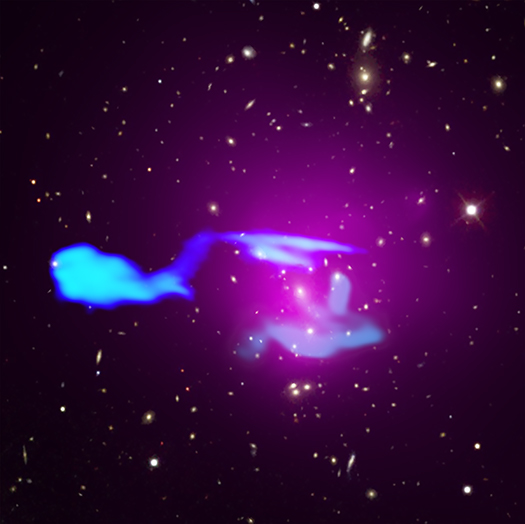
Credit: X-ray: NASA/CXC/Leiden Univ./F. de Gasperin et al;
Optical: SDSS; Radio: LOFAR/ASTRON, NCRA/TIFR/GMRT

USS Enterprise NCC 1701
Credit: Smithsonian National
Air & Space Museum
Hidden in a distant galaxy cluster collision are wisps of gas resembling the starship Enterprise — an iconic spaceship from the "Star Trek" franchise.
Galaxy clusters — cosmic structures containing hundreds or even thousands of galaxies — are the largest objects in the Universe held together by gravity. Multi-million-degree gas fills the space in between the individual galaxies. The mass of the hot gas is about six times greater than that of all the galaxies combined. This superheated gas is invisible to optical telescopes, but shines brightly in X-rays, so an X-ray telescope like NASA's Chandra X-ray Observatory is required to study it.
Happy 40th Birthday, Einstein Observatory
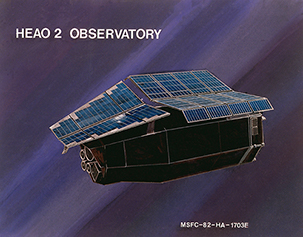
Einstein Observatory/HEAO 2
On November 13, 1978, the High Energy Astrophysical Observatory 2 (HEAO-2) blasted into space from Cape Canaveral, Florida. Renamed the Einstein Observatory after it was successfully placed into orbit, this was the first fully imaging telescope dedicated to looking at X-rays beyond the Sun.
The Einstein Observatory and the Smithsonian Astrophysical Observatory (SAO), part of the Harvard-Smithsonian Center for Astrophysics in Cambridge, Mass., are forever linked. The telescope was conceived, proposed to NASA, run by, and its data processed by SAO. The original conception for Einstein came from a group at the American Science & Engineering company, led by Nobel Prize-winner Riccardo Giacconi, which moved to SAO in 1973. SAO’s Leon van Speybroeck, who would later become the Telescope Scientist for Chandra, designed the telescope for Einstein.
In addition to being the first X-ray telescope capable of making images, Einstein was an extremely important mission for other reasons. For example, the Einstein Observatory set aside about a quarter of its observing time for a “Guest Observer” program. SAO’s Fred Seward headed the Guest Observer program and ensured an open, competitive process that enabled scientists who were not part of the original consortium to propose observations and to analyze Einstein data.
Playing it Safe: Chandra's Return to Science Observations
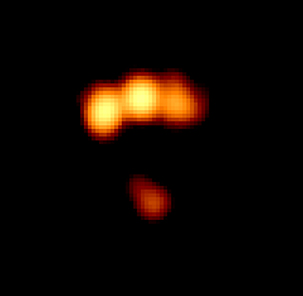
Credit: NASA/CXC/Trinity University/D. Pooley et al.
On October 10th, NASA’s Chandra X-ray Observatory went into “safe mode,” following a glitch on one of the telescope’s gyroscopes. After hard work by the team at the Chandra X-ray Center, the problem was identified and solved, allowed Chandra to resume science observations less than two weeks later on October 21st.
One of the first targets that Chandra looked at after its return to science was PS 0147+4630, a gravitationally-lensed quasar. What is that exactly? A quasar is a supermassive black hole that is rapidly consuming gas from its surroundings. The gas falls into a disk around the black hole where it becomes hot and generates prodigious amounts of radiation. Gravitational lensing is a phenomenon, first predicted by Einstein, where light from a very distant source is bent by a massive intervening object, such as a large galaxy or a galaxy cluster. This creates multiple images of a single, faraway object and amplifies the brightness of the light, acting in some ways as a natural magnifying glass.
Skeletons and Spacecraft: An X-ray Halloween

It’s that excellent time of year again when skeletons become all the rage. With Halloween just around the corner, the good folks at the Oregon Zoo released a series of X-ray images that show the fascinating — and a little bit spooky — skeletons of some of their animals.
Those of us who work for NASA’s Chandra X-ray Observatory share an affinity for X-ray images. After all, we’ve been in the business of collecting X-rays from space for nearly 20 years. During that time, we’ve observed X-rays coming from material falling into black holes, the remains of exploded stars, galaxies, and much, much more.
What’s the connection between X-rays from a doctor’s (or vet’s office) and those of a space-based telescope? A medical X-ray machine consists of two parts: an X-ray source at one end, and a camera at the other. The body or body part is placed in between. When the X-rays from the source shine, the camera records the X-rays that reach the photographic film or detector.
Carnival of Space
The Carnival of Space is a round up of astronomy and space-related blogs that started back in 2007. Every week, a different webmaster or blogger hosts the carnival, showcasing articles written on the topic of space. This week, it's our turn to host the Carnival here on the Chandra blog. Enjoy!
There’s a lot of news happening out there on the ground so let’s make sure we keep an eye on the latest from space in this week’s Carnival of Space.
At Universe Today, there were a slew of good posts to consider:

Artist’s impression of SpaceX’s proposed Mars Base Alpha. Credit: SpaceX
Author Matt Williams discusses how his experience as a science journalist helped become a better science fiction writer. https://www.universetoday.com/140285/how-science-journalism-helped-me-b…
Tammy Plotner takes us on a tour of the globular cluster NGC 6681, a.k.a. Messier 70, in their series of Messier Monday. https://www.universetoday.com/37776/messier-70-1/
A report on the recent acquisition of a Danish freighter by Blue Origins updates us on the latest from the race to affordability by private space companies: https://www.universetoday.com/140375/blue-origin-will-be-landing-its-ro…
Q&A on Chandra's Safe Mode and Gyroscopes, Part II
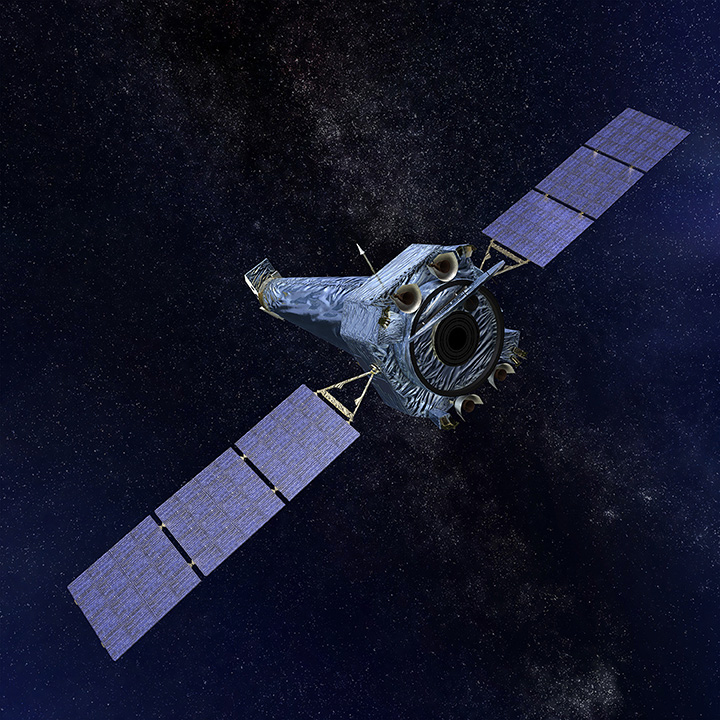
(Q&A on Chandra's Safe Mode and Gyroscopes, Part I)
On October 21, Chandra returned to science observations, less than two weeks after a glitch in one of its four gyroscopes caused it to go into Safe Mode. To answer some of the questions surrounding Chandra’s gyroscopes, members of the Chandra X-ray Center and its Flight Operations Team have put together this Q&A.
Angle Matters: A New Perspective on Neutron Star Collisions Solves an Old Mystery

Eleonora Troja
We are very pleased to welcome Eleonora Troja as our guest blogger. She is an associate research scientist at the University of Maryland, College Park, with a joint appointment at NASA Goddard Space Flight Center. She divides her time between her research on colliding neutron stars, directing the Swift Guest Investigator Program, and her three-year-old daughter, Bianca.
A year ago, on October 16th 2017, an amazing discovery was announced. GW170817, a collision of two neutron stars seen through gravitational waves and light, had realized the perfect union of two worlds. At the press conference organized by the National Science Foundation, a journalist asked an important question to the panelists: “Hadn’t we seen similar events before?” In that moment my mind ran back to an unusual gamma-ray burst, GRB150101B, localized by NASA’s Swift satellite nearly three years earlier.
GRB150101B was a flash of gamma-ray radiation that lasted for less than a fraction of a second. It was one of the weakest explosions ever seen with Swift, yet it was very luminous in X-rays and for a very long time. This was so unusual that Swift scientists were not sure whether the burst was a gamma ray burst (GRB) or another type of weird explosion, and dubbed it with a dual name GRB 150101B / SwiftJ123205.1-1056. I asked that NASA’s Chandra X-ray Observatory observe this object and help us unravel the mystery of its nature. Chandra revealed that there were two sources of X-ray light, not resolved by the Swift observations. A bright X-ray source was located at the center of the galaxy, probably indicating the presence of a supermassive black hole. Next to it, Chandra discovered a weaker X-ray signal coming from GRB150101B. At the same position, telescopes caught a glow of visible light which quickly faded away.
Chandra Operations Resume After Cause of Safe Mode Identified
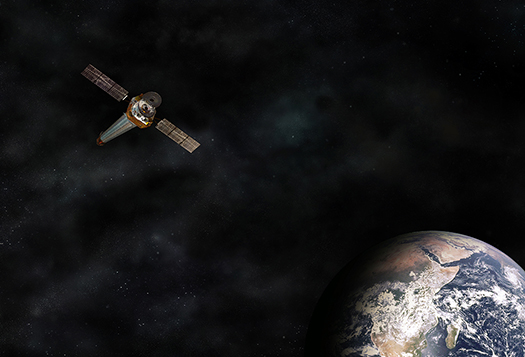
At approximately 9:55 a.m. EDT on October 10, 2018, NASA’s Chandra X-ray Observatory entered Safe Mode, where the telescope’s instruments are put into a safe configuration, critical hardware is swapped to back-up units, the spacecraft points so that the solar panels get maximum sunlight, and the mirrors point away from the Sun. All systems functioned as expected and the scientific instruments are safe.
The cause of Chandra's safe mode on October 10 has been researched and the Operations team has successfully returned the spacecraft to its normal pointing mode. The safe mode was caused by a glitch in one of Chandra's gyroscopes resulting in a 3-second period of bad data that in turn led the on-board computer to calculate an incorrect value for the spacecraft momentum. The erroneous momentum indication then triggered the safe mode. The team has completed plans to switch gyroscopes and place the gyroscope that experienced the glitch in reserve. Once configured with a series of pre-tested flight software patches, the team will return Chandra to science operations which are expected to commence next week.
Below are some questions and answers with additional technical detail, incorporating the latest information as of Monday October 15th, 2018.

